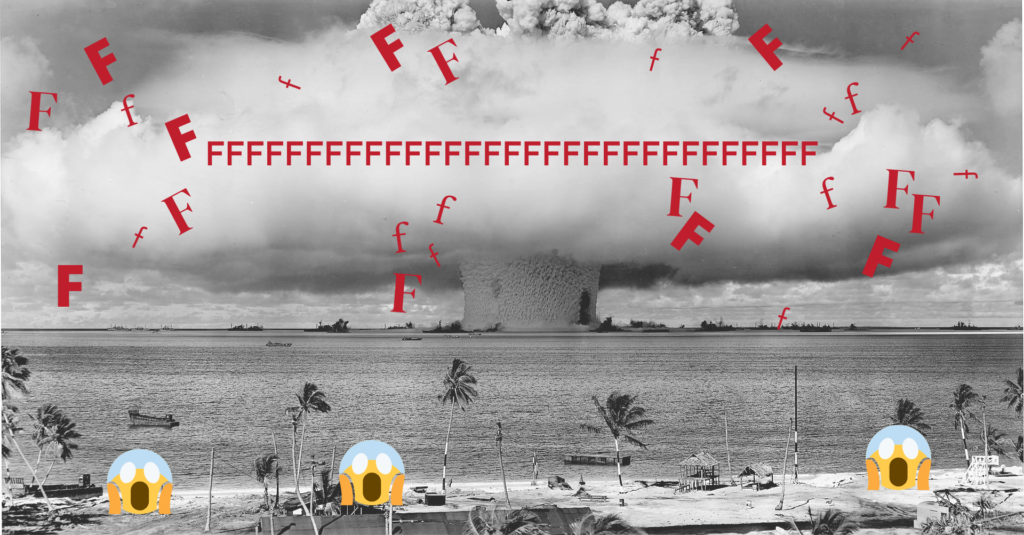- a student free speech case;
- a(nother) challenge to Obamacare;
- a voting law/voting rights case;
- a gay rights vs. religious freedom case;
Actual Footage of Incident:
 The plaintiff was, at the time in question, a high-school freshman who tried out for a spot on the varsity cheerleading squad. She was not selected, and, in the sage words of Justice Breyer, “she did not accept the coach’s decision with good grace.”
She took to Snapchat’s “stories” to voice her displeasure with two photos. Snapchat stories are deleted from Snapchat after a 1-day period, but others who view the stories can take copies of them, and herein lies the rub.
One of the photos posted on Snapchat expressed her anger that she had been told a “year of jv” was required before advancing to the varsity squad, even though another freshman had been selected for the varsity squad. In the words of Justice Breyer, again, this photo contained “an upside-down smiley-face emoji.”
Apparently nobody objected to the upside-down smiley-face emoji.
The other photo showed the plaintiff B.L. together with one of her friends. Both fine young ladies were giving the one-finger salute to the camera, along with a caption that stated “F*** school f*** softball f*** cheer f*** everything” [the snapchat story did not use the asterisks, neither did SCOTUS in its opinion].
Anyway, the 24-hour shelf-life (or half-life, since we’re talking about bombs…?) of the story was plenty of time for one of B.L.’s friends to save a picture of the story and snitch on her to, apparently, the entire school. Once the photos reached school administration, B.L. was suspended from the cheerleading squad.
A proportionate response was thus called for, and a federal lawsuit was filed.
While you might question (with some very understandable and valid reasons) whether the Supreme Court should really be spending its time adjudicating disputes about high school cheerleading squads, the issue of student speech actually does rear its head from time to time. Recall, if you will, the 2007 Morse v. Frederick case – better known as the “Bong Hits 4 Jesus” case – in which the students lost in a 5-4 SCOTUS ruling that they could be punished for unfurling a “Bong Hits 4 Jesus” banner across the street from the school (not on school property!!!).
This case is one of my favorites because, while the students lost in court, they undoubtedly have claimed victory in the land of memes. Just search “Bong Hits 4 Jesus” and try not to chuckle at some of the results.
But, back to B.L. and her Snapchat F-Bombs. B.L. won at the District Court on the grounds that there was no evidence her F-Bombs had interfered with the work of the school. The Third Circuit affirmed on a different basis (because the speech was off-campus; but cf. the rejection of this rationale by SCOTUS in Morse v. Frederick). SCOTUS specifically addressed the Third Circuit’s rationale in its ruling, stating that there was no had and fast bright-line rule relating to on-campus/off-campus vis-a-vis determining what speech is protected, although it did state that schools will rarely have much of an interest/right to regulate off-campus “political or religious” speech (although it did not define that term, which in the pre-smartphone days might have been considerably less slippery than it has now become).
SCOTUS also took pains to point out that, while schools have an interest in maintaining a learning environment under Tinker v. Des Moines Independent Community School District (the controlling precedent for many of these kinds of cases), they also have – or at least should also have – an interest in protecting free speech, even (especially) unpopular free speech.
In its application of the Tinker rule, the 8-1 majority held that the student B.L. won.
Justice Clarence Thomas dissented, maintaining his previous position that students have zero, zilch, nada, and nothing in the vein of free-speech rights. Thomas previously noted in Morse v. Frederick that during “the colonial era, … teachers managed classrooms with an iron hand.” This included, among other things, a Vermont case from 1859 that upheld a teacher’s right to beat a student for calling him “old” – and, presumably, if teachers can beat students, they can certainly censor students. The other justices in the majority in that case didn’t join Thomas’s opinion.
Justices Alito and Gorsuch joined the majority but also wrote separately to discuss in more detail some of the factors weighed by the court. They noted that this was the first time SCOTUS has addressed “true off-premises student speech” in light of the Morse v. Frederick ruling that “across the street from the school” is not really “off campus”. It’s not at all obvious to me that this distinction is meaningful in the age of the smartphone (Snapchat stories could be accessed on-campus or off-campus; it doesn’t really map).
For any future updates on legal developments, be sure to follow this blog, and check back regularly.
To talk with us about representing your business, contact us here.
The plaintiff was, at the time in question, a high-school freshman who tried out for a spot on the varsity cheerleading squad. She was not selected, and, in the sage words of Justice Breyer, “she did not accept the coach’s decision with good grace.”
She took to Snapchat’s “stories” to voice her displeasure with two photos. Snapchat stories are deleted from Snapchat after a 1-day period, but others who view the stories can take copies of them, and herein lies the rub.
One of the photos posted on Snapchat expressed her anger that she had been told a “year of jv” was required before advancing to the varsity squad, even though another freshman had been selected for the varsity squad. In the words of Justice Breyer, again, this photo contained “an upside-down smiley-face emoji.”
Apparently nobody objected to the upside-down smiley-face emoji.
The other photo showed the plaintiff B.L. together with one of her friends. Both fine young ladies were giving the one-finger salute to the camera, along with a caption that stated “F*** school f*** softball f*** cheer f*** everything” [the snapchat story did not use the asterisks, neither did SCOTUS in its opinion].
Anyway, the 24-hour shelf-life (or half-life, since we’re talking about bombs…?) of the story was plenty of time for one of B.L.’s friends to save a picture of the story and snitch on her to, apparently, the entire school. Once the photos reached school administration, B.L. was suspended from the cheerleading squad.
A proportionate response was thus called for, and a federal lawsuit was filed.
While you might question (with some very understandable and valid reasons) whether the Supreme Court should really be spending its time adjudicating disputes about high school cheerleading squads, the issue of student speech actually does rear its head from time to time. Recall, if you will, the 2007 Morse v. Frederick case – better known as the “Bong Hits 4 Jesus” case – in which the students lost in a 5-4 SCOTUS ruling that they could be punished for unfurling a “Bong Hits 4 Jesus” banner across the street from the school (not on school property!!!).
This case is one of my favorites because, while the students lost in court, they undoubtedly have claimed victory in the land of memes. Just search “Bong Hits 4 Jesus” and try not to chuckle at some of the results.
But, back to B.L. and her Snapchat F-Bombs. B.L. won at the District Court on the grounds that there was no evidence her F-Bombs had interfered with the work of the school. The Third Circuit affirmed on a different basis (because the speech was off-campus; but cf. the rejection of this rationale by SCOTUS in Morse v. Frederick). SCOTUS specifically addressed the Third Circuit’s rationale in its ruling, stating that there was no had and fast bright-line rule relating to on-campus/off-campus vis-a-vis determining what speech is protected, although it did state that schools will rarely have much of an interest/right to regulate off-campus “political or religious” speech (although it did not define that term, which in the pre-smartphone days might have been considerably less slippery than it has now become).
SCOTUS also took pains to point out that, while schools have an interest in maintaining a learning environment under Tinker v. Des Moines Independent Community School District (the controlling precedent for many of these kinds of cases), they also have – or at least should also have – an interest in protecting free speech, even (especially) unpopular free speech.
In its application of the Tinker rule, the 8-1 majority held that the student B.L. won.
Justice Clarence Thomas dissented, maintaining his previous position that students have zero, zilch, nada, and nothing in the vein of free-speech rights. Thomas previously noted in Morse v. Frederick that during “the colonial era, … teachers managed classrooms with an iron hand.” This included, among other things, a Vermont case from 1859 that upheld a teacher’s right to beat a student for calling him “old” – and, presumably, if teachers can beat students, they can certainly censor students. The other justices in the majority in that case didn’t join Thomas’s opinion.
Justices Alito and Gorsuch joined the majority but also wrote separately to discuss in more detail some of the factors weighed by the court. They noted that this was the first time SCOTUS has addressed “true off-premises student speech” in light of the Morse v. Frederick ruling that “across the street from the school” is not really “off campus”. It’s not at all obvious to me that this distinction is meaningful in the age of the smartphone (Snapchat stories could be accessed on-campus or off-campus; it doesn’t really map).
For any future updates on legal developments, be sure to follow this blog, and check back regularly.
To talk with us about representing your business, contact us here. 
